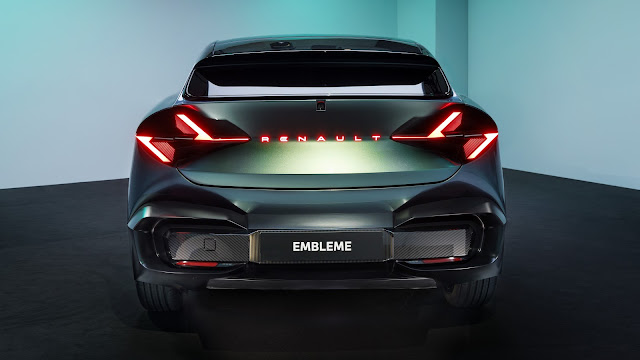The Soul of Sustainable Mobility on Trial
At the epicenter of the green revolution shaping the automotive industry, Renault has unveiled the Emblème. Far from being just a styling exercise, this ambitious prototype is a true rolling laboratory, heir to the pioneering vision of the 2022 Scenic Vision.
The objective? To break new ground in decarbonization, materializing a future where spacious, comfortable, and technology-filled family cars go hand in hand with a healthier planet.
The Emblème's approach, says Renault, is comprehensive, analyzing every stage of the vehicle's life, from conception to recycling, under five essential pillars: eco-design, conscious material selection, optimized production, efficient usage, and a circular lifecycle.
Born from Ampere's expertise, the Emblème is not just a promise; it is a tangible demonstration of how a family car can be rethought from the ground up to emit an impressive 90% less greenhouse gases than an equivalent 2019 model.
Every decision, every material, every technology embedded in the Emblème has been scrutinized through the lens of maximum decarbonization. Renault has not settled for obvious solutions, exploring intelligent and viable combinations in areas such as resources, production, and, crucially, how the car is used and what happens to it at the end of its useful life.
The result is remarkable, a 70% reduction in the carbon footprint of parts production. But not only that, half of the materials that make up the Emblème are recycled, and almost all of it can be reused in the future. The synergy between engineers and designers has made it possible to sculpt an elegant 4.80-meter "shooting brake," where the exterior lines combine with a technologically advanced interior and a deep environmental awareness.
The interior of the Emblème is a space of contemporary design. The eye is immediately drawn to the vast "wide openR" panoramic screen that redefines the instrument panel. And beneath the rear floor pulses an innovative dual-energy electric powertrain, combining the versatility of electricity with the promise of long-distance, low-carbon travel provided by hydrogen.
Renault wants to shape the future of mobility. The Emblème is living proof of the Group's commitment to achieving carbon neutrality, an ambitious goal that passes through Ampere and its dedication to intelligent electric vehicles. This prototype is not an end in itself, but rather a beacon illuminating the path to a new era.
Radical Eco-Design
Achieving the target of 5 tonnes of CO2eq required an unprecedented eco-design approach from Ampere. From the first sketch to the choice of each component, the pursuit of emissions reduction was relentless. Designers and engineers worked in harmony, driven by high-performance tools to innovate in every detail, from the exterior aerodynamics to the cabin materials and the powertrain development.Cléa Martinet, Vice President of Sustainability for the Renault Group, emphasizes the project's ambition:
"The Renault Emblème responds to the challenges of decarbonization. It concentrates the engineering and innovation solutions necessary for the cars designed and produced by the Renault Group to aspire to net-zero carbon. It incorporates decarbonized and resource-respectful mobility, conceived from design to end-of-life, in an ecosystemic and collective way, with our partners and suppliers throughout the value chain. In addition to anticipating the next design silhouettes, it integrates technologies developed by Ampere, which will be gradually introduced in the next generations of vehicles."
Less Weight is More
The weight of a vehicle is a crucial factor in its emissions, influencing everything from the extraction of materials to energy consumption during use and recycling. To keep the Emblème at around 1,800 kilograms, the designers sought to eliminate every unnecessary gram without compromising comfort and safety.A Collaboration that Decarbonizes
Achieving a 70% reduction in the carbon footprint of parts production was a joint effort involving more than twenty specialist partners. Each brought their expertise and technology to optimize decarbonization without sacrificing quality.From AKWEL, which redesigned door handles with recycled materials and a simplified mechanism, to ArcelorMittal, which supplied high-strength steels with a high content of circular material and production using renewable energy, collaboration was key. Autoneum revolutionized thermal and acoustic insulation with recyclable monomaterial polyester fibers, while Dicastal created lightweight aluminum wheels with 70% recycled material. Michelin developed tires with optimized rolling resistance, and OPMobility innovated in the low-carbon carbon fiber hydrogen tank.
Inside, Forvia focused on recycled and natural materials such as flax and pineapple, which act as carbon sinks, and optimized assembly processes to facilitate recycling. Forvia Hella drastically reduced headlight emissions with Fresnel lenses and recycled materials. Constellium supplied recycled and low-carbon aluminum for the doors, demonstrating the circularity of the material. ST Microelectronics applied its SiC technology for a more efficient and ecological traction inverter. Valeo reinvented the wiper system with recycled materials and a design that saves cleaning fluid. And Verkor designed an electric battery with a 72% reduction in carbon emissions.
Even the seat upholstery was rethought, with the use of recycled and recyclable polyester, dyed via an innovative process that eliminates the need for traditional dyes.
Pascal Tribotté, Renault Emblème Project Manager, summarizes the spirit of this collaboration:
"With the Emblème, we wanted to drive the automotive industry ecosystem towards more sustainable mobility. This decarbonization laboratory was designed to operate without compromising functionalities such as comfort, safety, and connectivity. It is the result of an exploratory, horizontal, and collective approach. Between the Renault Group and 20 partners, all experts in their fields, barrier-free innovation allowed us to achieve the ambitious decarbonization target set at the beginning of the project."











